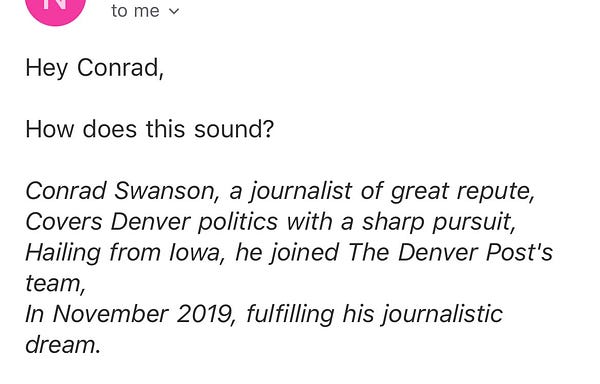The new standard for PR pitches in the ChatGPT era
How we adapt to journalists' justified skepticism
Five months ago, this PR pitch could have been held up as an exemplary piece of hustle, creativity and personalization. Now it is offensive to its recipient.


The difference between now and five months ago, of course, is ChatGPT, which had to have written this pitch.
So how do we adapt? How do we appropriately target journalists and craft pitches that intrigue them in an era where we’re fighting for their attention against an inbox full of computer-generated content?
It’s actually not as scary as it sounds. To understand why, it’s helpful to time-travel back about 25 years.
I had the good fortune to start my PR career in the late 90s, smack dab in the middle of the transition from fax-and-phone to email as the primary pitching medium. From a journalist’s perspective, the evolution went like this, over a period of years:
“Hmm, I wonder if I got any emails today . . . cool, here’s one!”
“Okay, now all the PR people are emailing me press releases instead of faxing me, ugh.”
“Look, this PR person addressed me by name, this must actually be relevant to me.”
“Crap, they figured out how to automatically insert my name into every pitch, then still send me the same generic pitch they used to blast-fax everyone.”
“Oh cool, this PR person is mentioning a recent story I actually wrote, they must have actually researched me and chosen me for a reason.”
This:
So you can see how a technological innovation - email - could have enabled a more individualized, relationship-centered approach to pitching. Instead, the tech innovation was abused and eventually descended to the common denominator of transactional blasting, just like the blast fax before it.
Now we have a newer technological innovation - generative AI. And journalists jaded by the abuse of email are naturally now automatically assuming that any pitch that appears to have required a remarkable amount of effort was actually created by ChatGPT and is being scaled across a lengthy media list.
And now the good news - all you have to do to stand out is not be that bad!
The new standard for pitching media in the AI era:
Pitches must be written such that the journalist receiving them cannot immediately tell whether AI wrote them or not.
Notice that this standard does NOT mean you can’t use AI to craft your pitches. You’d be foolish not to. It just means you need to apply your human wisdom, common sense and creativity to using the tool so that the end product is actually relevant and appropriate for its recipient. Ultimately, when the journalist sees that it’s relevant and potentially useful, they won’t really care how it was written.
How might the author of the ill-fated poem pitch at the top of this post have better applied an AI tool?
Right now the most efficient way to do this would be with Microsoft’s Bing Chat or Google’s Bard, which are not yet widely available. The limitation of ChatGPT is that its training database cuts off in September 2021 (which it incessantly reminds you every time you ask it something like this). But very soon, all of us are going to have access to Bing and Bard and ChatGPT’s browser plugin - it’s only a matter of the waitlist. So here’s how you’d proceed using those tools.
Since Conrad covers environment and politics for the Denver Post, let’s say hypothetically we represent a Colorado agriculture company that has a point of view about water usage and water rights in the state. We’d start by asking our tool to:
Summarize recent stories Conrad Swanson of the Denver Post has written about agricultural water rights.
And then paste in our latest news or the message points our SME has to share in bullets and then ask:
Why might Conrad be interested in this information?
Based on the summaries of his most recent stories, pick the most likely of the reasons the tool suggests, and feed that back into the bot:
Draft an email to Conrad explaining why [our information] relates to [reason the tool suggested].
And then you’ve got your first draft of your pitch. It very well reads like a bot wrote it. Because you follow the standard of pitching in the AI era asserted above, you edit it so it sounds like YOU wrote it. Because you did. You just wrote it about 30 minutes faster than you would have if you did the research and first draft yourself.
Realistically speaking, several months from now, maybe a year, someone will have stitched together various tools so that you can simply drop your media list and your news into a couple of form fills and it will crank out all of the above in a split second. And then THAT will be the new lowest common denominator that lesser PR pros start to abuse, and journalists will protest on Twitter.
And we’ll adapt again 🙂
In future editions of this newsletter, I’ll be sharing actual prompts and outputs for real pitches. Would love to hear from you about your own successes!





